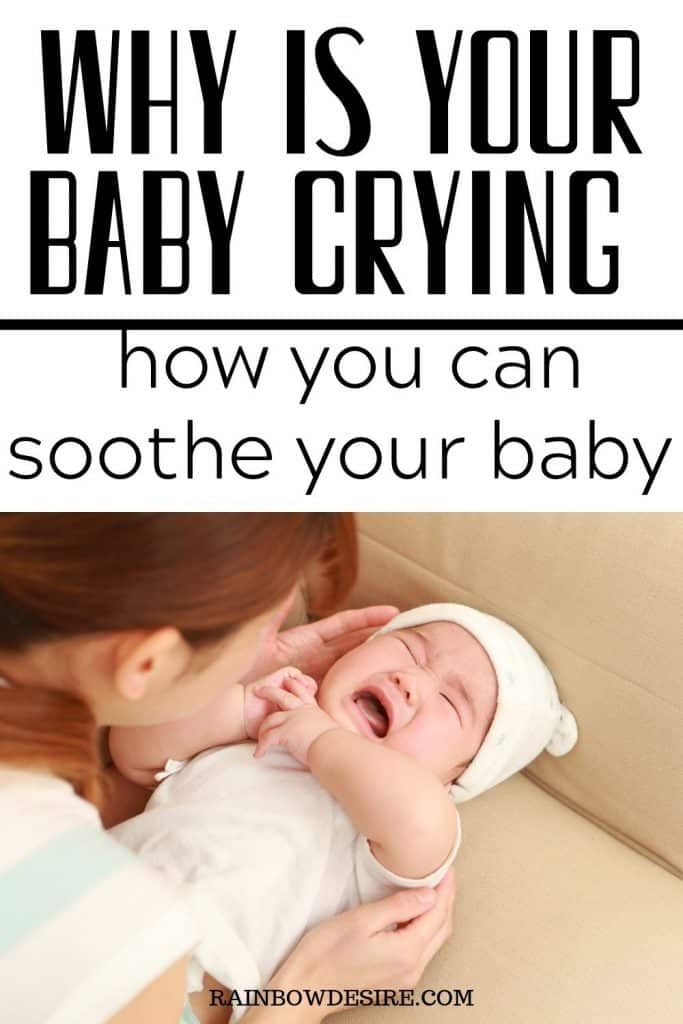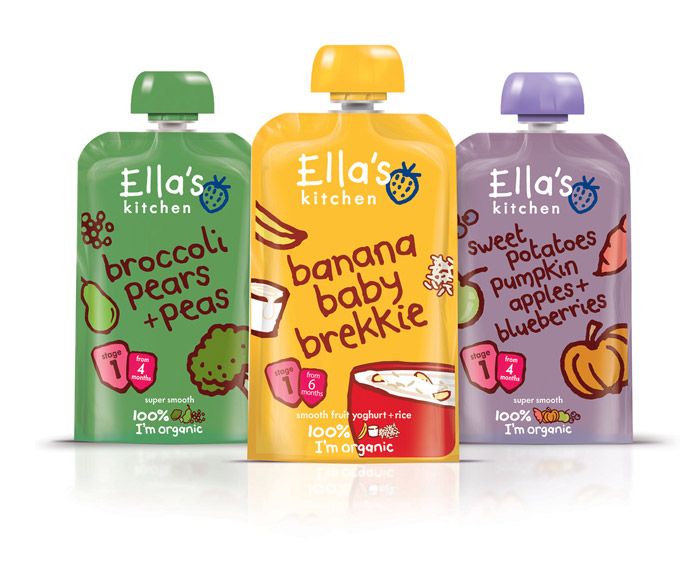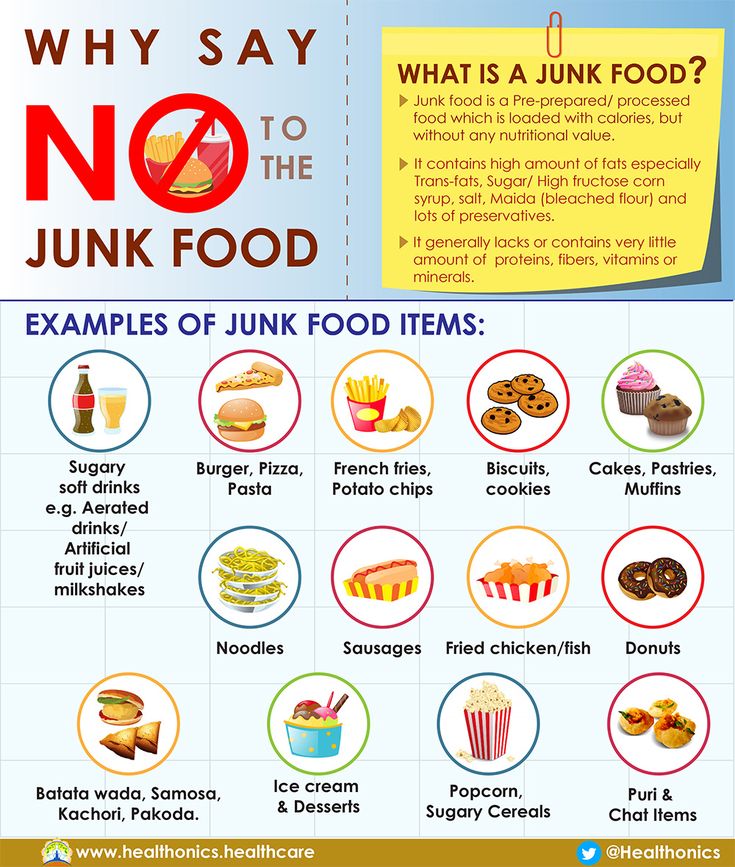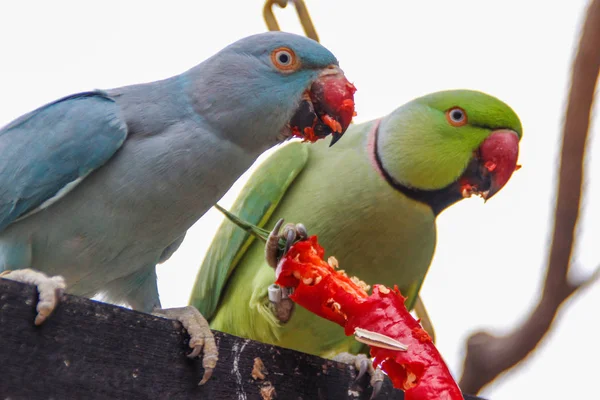Baby crying when feeding solids
Why Baby Crying While Eating Solids?
Baby
ByWinters
HoursUpdated:
Many parents are concerned about their baby’s eating habits and whether or not they are eating solid foods. It might not signify anything wrong if your baby is crying while eating solids.
The cry might simply be a reflexive response to the stimulation of eating and may gradually subside as your baby becomes more used to the new experience.
However, if your baby constantly cries while eating solids, there may be a problem. It could mean that they do not feel comfortable with the experience and are not enjoying it.
This can signify that your baby isn’t getting enough source of nutrition or is experiencing another issue. If you’re concerned about your baby’s eating habits, keep reading to discover how to introduce solids.
Introducing solid foods to a babyIf you are ready to introduce solid foods to your baby, you should know a few things. First, make sure your baby is healthy enough to eat solid foods. If your baby has a fever, is not eating well, or has other signs of illness, wait until he or she is better before introducing solid foods.
Second, feed your baby slowly and carefully to avoid choking. Besides, don’t put pressure on the body. Start with soft baby foods like pureed fruits and vegetables and move on to harder solids.
When introducing solid foods to your baby, it is essential to be careful not to overwhelm them. Start with small amounts of pureed fruits and vegetables, followed by cooked meats and poultry.
You can also try giving your baby a small amount of breast milk or formula mixed with pureed foods. Babies are often hesitant to try new foods at first, but with consistency and patience, they will eventually become interested in solid foods.
When to introduce solids to your babyIntroducing solid foods to your little one seems like a big decision, but it may have a significant impact on their health and development. Start giving your baby solids when your baby reaches 6 months old6 months is the age at which most babies become interested in food.
Start giving your baby solids when your baby reaches 6 months old6 months is the age at which most babies become interested in food.
By this point, they’ve developed enough motor skills to grab objects and try to put them in their mouths. This means it’s time to introduce them to solid foods. There isn’t a specific timetable for when you should start giving your baby solids, but you should generally start by offering small pieces of soft food.
You may try combination feeding with breastmilk or formula milk and some soft solids. Once your baby shows interest in these small couple of bites, gradually increase the size of the pieces until they’re eating solid foods. Be patient! Remember that Introducing a solid meal to your baby is a gradual process.
Don’t overdo it too much too soon can cause your baby to develop food allergies or vomiting. Instead, be gentle and let your baby explore their world through food. Also, monitor the baby’s poop colors to check how the diet affects them.
Here are some common reasons your baby may be crying while eating solids:
Hungry/Full:If your baby is crying because he is hungry/full, give him some breast milk or formula as soon as possible. If he is still crying after you’ve given him a meal, try giving him smaller meals more frequently throughout the day.
Tired and uncomfortable:When trying to eat new solids, the baby may easily feel overwhelmed and tired. It may also make the baby feel uncomfortable.
If your baby is crying because he’s under too much stress, try to relieve his stress by doing something he enjoys, such as holding him, going for a walk outside, or reading him a story.
Some babies cry or are colicky baby at the beginning of the breastfeeding schedule. Similarly, eating solids may be new to them to feel comfortable enough.
Teething:A teething baby may become fussy and less willing to try new foods.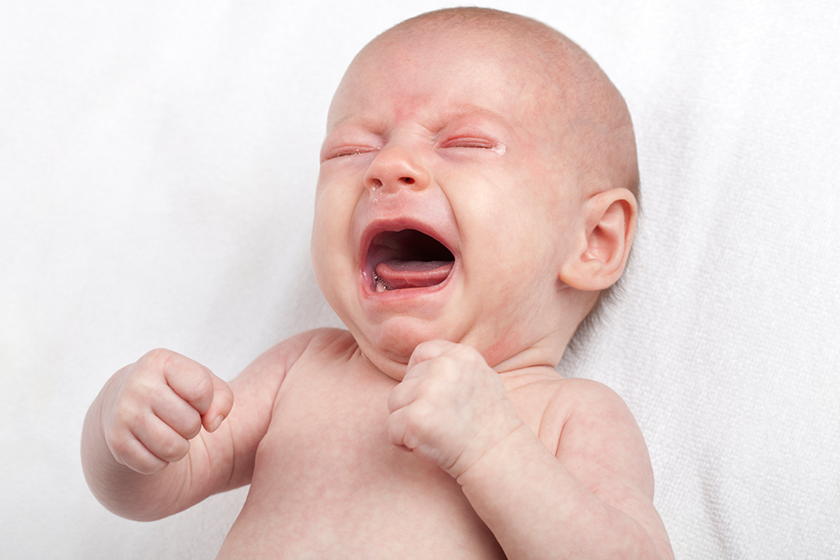 When a teething baby may want breast milk instead of new solid foods.
When a teething baby may want breast milk instead of new solid foods.
Learn how to ease a teething baby to offer comfort. Another way to soothe teething babies is to give them frozen vegetables and bananas.
New texture:A new food may send the baby into a sensory shock. Some babies may not like a particular food because of its texture. With some trials, you may have to figure out the best texture and food combinations.
Some babies may prefer pureed fruits and vegetables. On the other hand, some may like apples or carrots cut into bite-size pieces.
Tips for introducing certain solid foods to your baby’s dietWhen introducing solid foods to your baby, it’s essential to keep in mind their developmental stage and dietary needs. Here are some tips for introducing certain solids to your baby’s diet:
- Start by offering small breast milk or infant formula diluted with water as the first food. Once your baby is able to consume these diluted feeds without any problems, gradually increase the number of solids offered.

- Introduce boiled vegetables and mashed bananas as the first solid foods to infants. Be sure to offer plenty of fluids with this meal, so your baby gets the hydration they need.
- Offer fruits and vegetables early on, but be gentle when trying to feed them to your infant. Try cutting up small pieces and feeding them one at a time so your baby can control how much they eat.
- Feeding your infant fruits and vegetables does not mean they need to start eating table food immediately – they can enjoy these foods later on once they are more developed and have learned how to eat properly.
- Wait until your baby is 6-7 months old before giving them dairy products, such as cow’s milk or cheese. This is because babies can’t digest these foods well before this age. If you do decide to introduce dairy products to your baby’s diet, be sure to give them in moderation.
By observing your baby’s eating habits and reacting accordingly, you can help them learn how to eat effectively. If your baby cries while eating solids, try to stay calm and reassure them that everything is okay. Introduce semi-solid food along with milk.
If your baby cries while eating solids, try to stay calm and reassure them that everything is okay. Introduce semi-solid food along with milk.
Try to provide a safe and comfortable environment for them to eat in, such as sitting on your lap or a chair with back support. If the crying continues after trying these measures, it may be necessary to consult with a doctor to keep your kid a healthy baby.
Faqs:Why does my baby cry when I feed her baby food?Your infant may cry after eating for a variety of reasons, such as colic, gas, formula, acid reflux (gastroesophageal reflux disease), and food sensitivity or allergy. It is not necessary to nurse your child whenever they cry.
Should I worry about my baby gaining too much weight?However, unless it is creating issues for the mom or the baby, oversupply is not a problem. Rarely, health issues such as congestive heart failure, renal abnormalities, and/or endocrine diseases might be linked to excessive weight gain. It is even more crucial to keep breastfeeding if the kid has health issues.
It is even more crucial to keep breastfeeding if the kid has health issues.
Add some pureed pears or applesauce to the cereal for a terrific first fruit. She could be moved to open wide by the additional taste and texture. Alternatively, try a different kind of baby cereal. Some daring palates prefer the stronger flavors of barley or oats to the soft milkiness of rice.
References:https://www.redcross.org.uk/first-aid/learn-first-aid-for-babies-and-children/choking-baby#:~:text=Give%20up%20to%20five%20chest,and%20may%20dislodge%20the%20blockage.
https://intermountainhealthcare.org/blogs/topics/intermountain-moms/2015/11/teething-and-babies/
0 shares
Is Your Baby Crying While Eating Solids? Here’s Why
Introducing your baby to solid foods is exciting! Every parent knows to expect a bit of a mess during this stage. What they don’t expect, however, is crying.
What they don’t expect, however, is crying.
As a matter of fact, one of the most common questions parents have is, “Why is my baby crying while eating solids?”
Keep reading to learn all of the possible answers to that question. You’ll also find a couple of interesting things you’re likely to come across as you introduce solid foods to your baby.
Why Is My Baby Crying While Eating Solids?
Think about all those textures and different tastes awaiting your baby’s taste buds! It sounds so exciting and new, but that’s only because we know how good solid food tastes.
Your baby doesn’t; not yet anyway. Parents see their baby crying while eating solids and they freak out.
We know how important your baby’s dietary needs are, so we compiled a list of all the possible reasons why your baby is crying while eating solid food.
Read on to learn more.
1. Dry Foods
As you begin to introduce solid foods to your baby, remember that they’re still getting used to how food feels in their mouths.
Plus, it starts to coat their mouths and throats after a couple of bites. That’s another thing they’re still getting used to.
Maybe your baby is simply thirsty. Remember that they’ve enjoyed a liquid diet all their lives. Solids can make them feel thirsty even after the first few bites.
Make sure you have some type of liquid nearby so your baby can quench their thirst. This can be breast milk, formula, or water.
Also, find a cup that your baby feels most comfortable with. It’ll go a long way in easing their fussiness, especially when they’re eating solids.
Some babies like sippy cups. Others like cups with a straw. If your baby still wants to drink from their bottle, that’s okay too. Just make sure they’re happy and learning to enjoy their food.
2. Sore Gums
Teething is a time in your baby’s life when their gums will be pretty sore. It could be why your baby has been in such a bad mood lately.
It’s also hard for your baby to swirl solids, even pureed, in their mouths with swollen gums. So, they start to cry to try and get you to feel their pain.
So, they start to cry to try and get you to feel their pain.
If your baby isn’t accepting of solids because of teething, wait a few more days. If you don’t want to stop offering solids during this time, here are some soft foods you can try:
- Cottage cheese
- Bananas
- Apple sauce
- Pureed carrots
- Cold cucumbers
3. Trapped Wind
Is your baby gassy or constipated? Abdominal discomfort is one of the first things parents should keep an eye out for when their little ones are crying while eating solids.
Stomach discomfort isn’t something babies tolerate well. Heck, we don’t, why should they?
Then, you come and try to add to their pain by offering solids, and they just can’t take it anymore. So, they start crying.
Begin by checking your baby’s diaper. If it’s clean, try reflexology massage (Check the video below) on their stomach area to release any trapped gas. Massaging this area helps move things along to help relieve their constipation.
Remember to give your baby plenty of fluids if they’re constipated. Also, focus on giving them foods rich in fibers, such as whole grains, fruits, and veggies.
4. Bonding Time
Why is your baby crying while eating solids? Maybe they miss bonding with you. They’ve spent all of their lives safe and secure in your arms every time they ate. Who’d want to give that up?
If you feel that this is the case, take your baby in your lap and offer a piece of carrot or a spoonful of applesauce.
Do they stop crying? Are they more willing to eat solid foods now that they’re sitting comfortably in your lap? If yes, then, problem solved!
One thing to encourage your baby’s independence is to start feeding time in their high chair. If they cry, then you can put them on your lap. Don’t worry, they’ll grow out of it soon enough.
If they cry, then you can put them on your lap. Don’t worry, they’ll grow out of it soon enough.
5. Allergic Reaction
Food allergies are pretty common in babies. The good news is that most children outgrow them by the time they’re five.
If you feel your baby is allergic to a certain type of food, don’t offer it until you’ve talked with your pediatrician. Also, check to see if there’s any history of food allergies in your family.
Allergic reactions in babies come in many forms. They can include the following:
- Diarrhea
- Gassiness
- Mucus in the stool
- Hives, usually along the mouth
- Watery eyes
- Wheezing
- General crankiness
6. Sensory Shock
It takes time for babies to get used to the new texture and taste of solid foods. Even pureed solid foods are different from the liquid diet they’ve been used to for so many months.
Experts say that it can take your baby up to 20 times until they start accepting a particular food. So, follow your baby’s pace and just have fun. They’ll get the hang of it soon enough.
So, follow your baby’s pace and just have fun. They’ll get the hang of it soon enough.
7. A Bug
We’re not talking about the crawly, wriggly kind. We’re talking about the bug or cold that leads to your baby crying while eating solids.
Even a stuffy nose can make your baby cranky and fussy. That’s enough to get them to reject food altogether, not just solids.
The best thing to do is wait it out. It’ll be over in a couple of days, a week at the most. During this time, give your baby plenty of liquids, like breastmilk, water, and even warm herbal teas to make them feel better.
8. Right Timing
When you offer your baby solids, your timing has to be just right. If they’re hungry or too full, they’ll start crying when you offer solid foods.
Try to give small amounts of solid foods an hour after you’ve given your baby breast milk or formula.
This is the perfect time to develop their taste buds without relying on solids to be their main source of nourishment.
If your baby is full, chances are they won’t be interested in eating solids. At the same time, if you wait until your baby is hungry, they’ll be too fussy to accept anything new. All they’ll want is their comfort food, which is the milk they’re used to.
9. Cranky Baby
Babies cherish their naptime. If they’re tired after playtime or an outing, chances are they’ll be too cranky to accept any solids.
The best time to provide solid food is between giving them breastmilk or formula and between their naptime.
The ideal time would be in the afternoon or early evening when they’re in a more playful mood. They’ll be more willing to sit down and try new foods during this time.
10. Force Feeding
Your baby crying while eating solids could be because of how you’re handling the whole feeding process. Are you feeling anxious? Nervous? Angry, even?
Without saying a single word, your baby understands exactly how you’re feeling. They read your facial expressions.
So, if you’re frustrated, your baby will also get frustrated and scared. They may even feel pressured into eating. Then, later on in their lives, this negative experience with food can lead to health issues or eating disorders.
Smile a lot. Try not to focus on how much food actually makes it into your baby’s mouth. Instead, make feeding time playful and fun.
What to Expect When Feeding Your Baby Solid Foods
Starting on solids should be fun and enjoyable for you and your baby. Our advice for getting through this milestone in one piece is don’t set high expectations.
It can get hectic at times, but it’s a precious time in your baby’s life. Enjoy every moment so you can provide your baby with a positive feeding experience that will last their entire lives.
Also, remember to take it slow. Give your baby’s taste buds time to develop and get used to all the new tastes.
Here are a few things to expect when introducing solid foods to your baby.
- Your baby will make adorable funny faces as they experience new textures and flavors
- You’ll be cleaning your baby’s chair, the table, and the floor a lot! Embrace the mess.

- Introduce one food at a time and wait a week before offering a new one
- Be patient and, more importantly, be consistent at every meal
- Babies usually take longer to get used to veggies because they’re more bitter
- Mixing pureed solids with breast milk or formula, in the beginning, makes it tastier
- Don’t be surprised if you catch a glimpse of a piece of carrot or pea in their diapers!
When Is the Best Time to Start Feeding Your Baby Solids?
Many babies are ready for solids by the time they’re six months old. Experts recommend giving babies only breast milk or formula for the first six months.
Then, after six months, slowly cut back on the liquid diet while introducing small amounts of pureed solids. This is what their digestive systems are designed to handle.
So, don’t rush it. Some babies are more willing to try solid foods, whereas others will be more reluctant to begin this journey of discovery.
That being said, it’s also not a good idea to wait too long to introduce solids. Older babies may be more resistant to learning to chew and swallow. They’ve gotten used to the much simpler method of breastfeeding or bottle feeding.
Older babies may be more resistant to learning to chew and swallow. They’ve gotten used to the much simpler method of breastfeeding or bottle feeding.
Here are a few signs that your baby is ready for solid foods:
Baby-Led Weaning
Many parents wait until their babies have at least a couple of teeth and can sit up on their own before offering actual solids. It’s called baby-led weaning.
Baby-led weaning is when you skip the ‘pureed solids’ stage and go right into offering solids. These are usually thick pieces of sliced veggies or fruits that your baby can hold in their hands.
This usually takes place around eight months when they can hold out their index finger in a pincer grasp.
Interest in Table Food
You know your baby’s ready for solid foods when they begin to watch you eat. They may even try to grab your spoon and imitate what you’re doing.
This is a terrific sign and parents get excited when they see their adorable babies start to show interest in food.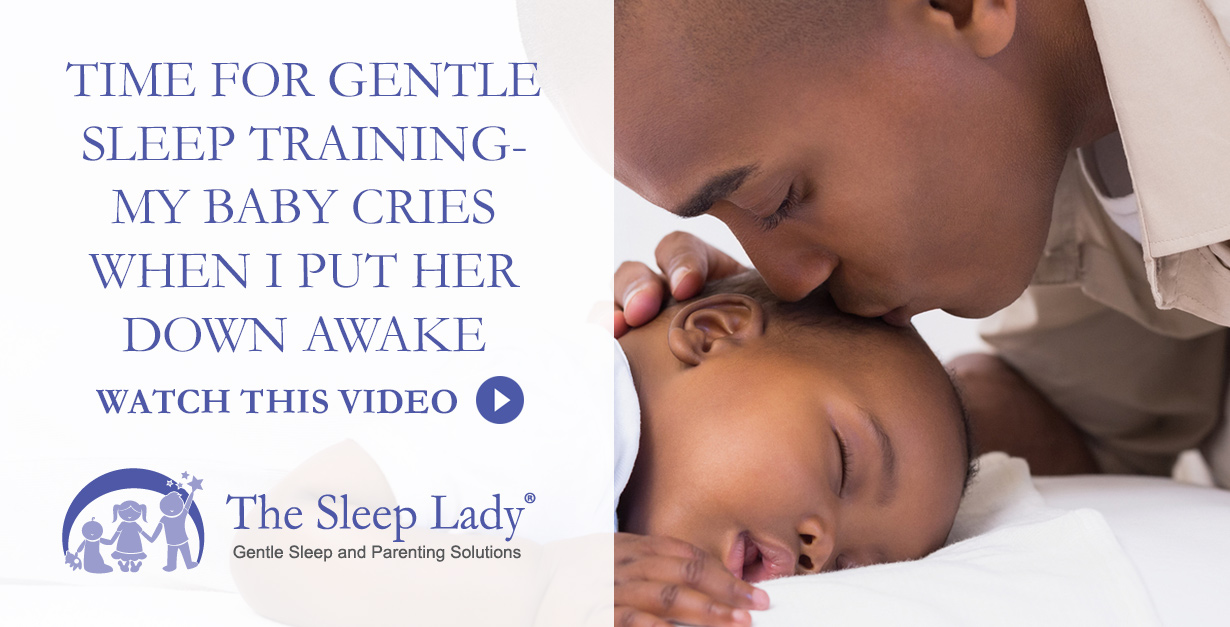 Yet, it can be dangerous because certain foods pose a choking hazard.
Yet, it can be dangerous because certain foods pose a choking hazard.
If your baby begins grabbing table foods, try not to leave them unattended. If you do, make sure you remove any foods that are choking hazards, such as the following:
- Whole grapes
- Popcorn
- Hot dogs
- Hard or sticky candy
- Raw veggies
Tongue Thrust Reflex
The tongue-thrust reflex is when your baby’s tongue pushes the food out. Thrust reflex is normal in all babies, but it’s a sign that your baby isn’t ready to be spoon-fed (Check the video below).
To figure out when your baby’s thrust reflex has disappeared. Mix some baby food with a drop or two or breast milk or formula. Place a tiny bit on a spoon or the tip of your finger and feed your baby.
If your baby takes the food, swirls it around a bit, then swallows, that’s great! This means your baby’s tongue thrust reflex has disappeared.
If the food comes back out as soon as you feed your baby, the reflex is still there. Wait a couple of more weeks, then try the test again.
A Final Note
To have your baby crying while eating solids is a normal part of the process; up to a point.
If they keep on crying, then you have to address the issue early on. It’s the best way to prevent any emotional problems your child may suffer when they’re older.
Remember to be patient and consistent. Your baby needs time to get used to this new type of diet.
Come up with creative ways to present solid foods to get your baby engaged. Also, it’s perfectly natural for your baby to play with their food. It’s their way of familiarizing themselves with the new textures and flavors.
So, relax and enjoy this precious time you have with your baby. It’ll be over before you know it.
Breastfeeding after 1 month: what to expect
Do you know when breast milk production stabilizes? And how does the frequency and duration of feedings change as the baby grows? You will find answers to these questions in our recommendations for breastfeeding after the first month.
Share this information
Congratulations: You made it through the first month of breastfeeding. Your breast milk has reached full maturity 1 , its production stabilizes, and it leaks almost or not at all from the chest. Don't worry, it's not getting less milk, it's just that your breasts are better able to produce and store it now. 2 At the age of six weeks, your baby will begin to please you with his charming toothless smiles, and by two months you will already have 500-600 feedings behind you. With a favorable development of events, problems with latch on by this point will already be resolved, and you can simply enjoy the convenience and benefits of breastfeeding. nine0003
nine0003
When does breastfeeding decrease?
"Normal" feeding frequency for babies aged one to six months varies considerably, with some needing four feedings a day, others asking to be breastfed 13 times a day. 3
“From the age of one month, the amount of milk a baby consumes per feed increases, so that he can go without food for longer,” explains Cathy Garbin, a recognized international expert on breastfeeding, “A baby’s stomach grows, so he eat more at one time. In addition, mature milk allows him to stay full longer.” nine0003
Feeding can last from 12 minutes to one hour -
the habits of babies vary so much! 3 But if the child is gaining weight and falls within this range, there is no cause for concern.
What is most surprising, no matter how often the baby eats, he consumes approximately the same amount of milk per day - both at one month and at six, when it is time to start complementary foods with solid food. 4
“However, sometimes the baby eats more and sometimes less, especially when he is unwell.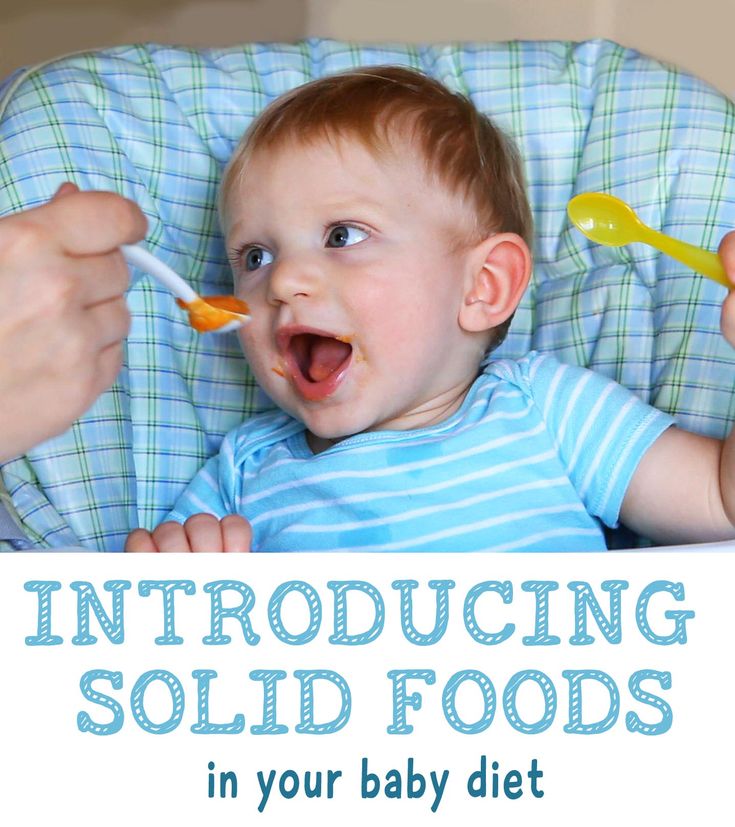 It’s better to just listen to his needs,” Katie explains. nine0003
It’s better to just listen to his needs,” Katie explains. nine0003
Is breast milk enough for the first six months?
Yes. Breast milk contains everything a baby needs for the first 90,023 six months of life—exclusively breastfed babies don't even need to drink more water! 5 Until about six months of age, a child's digestive system is simply not adapted to the digestion of solid food, and he will be able to drink cow's milk only after a year.
In addition, breastfeeding during this period prepares the child for further development. It strengthens the muscles of the mouth, develops the jaw and helps straighten the teeth 6.7 . All this will come in handy when the baby begins to eat and talk. And because what you eat and drink affects how your breast milk tastes, your baby discovers new tastes even before he starts eating solid foods. 8
In addition, when your baby is sick, your body produces breast milk that is
rich in antibodies that help fight infection.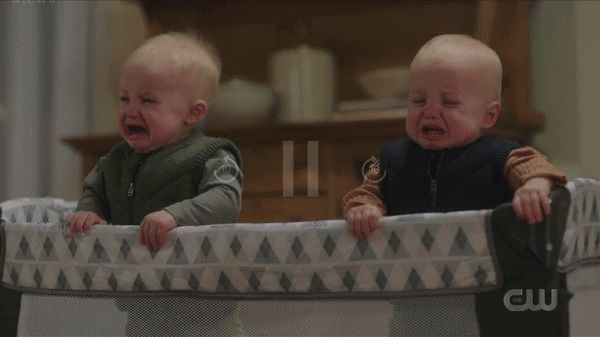 9 In other words, milk continues to protect the baby for many months as he grows and becomes more active. nine0003
9 In other words, milk continues to protect the baby for many months as he grows and becomes more active. nine0003
Breastfeeding is also very comfortable once you get used to it. Claudia, a mother of two from the UK, notes: “No need to sterilize a mountain of bottles, prepare formula, carry it all with you, warm it up - in general, breastfeeding turned out to be very convenient, especially when my babies grew up and we began to leave the house more often. ".
At what age does a breastfed baby start sleeping through the night?
Waking up at night is normal for babies. Most babies between the ages of one and six months consume a fifth of their daily milk requirement at night, so nighttime feedings should not be neglected if you want your baby to get the required amount of calories. nine0009 3
"It really depends on what you mean by 'sleep through the night'," says Cathy. "And it's better than waking up every two hours anyway! I have met infants who, starting at six weeks old, fell asleep at 19:00 and woke up at 7:00, but most continue to wake up frequently at night after this age. All children are different."
All children are different."
In Wales, a study of more than 700 infants showed that almost 80% of children aged 6 to 12 months wake up at least once a night, and 25% of them wake up three times or more. And it did not depend on what type of feeding the child is on - breastfeeding or artificial. nine0009 10
And if nighttime awakenings are unavoidable anyway, breastfeeding is at least comfortable! Maina, a mother of two from Australia, agrees: “You can even take a nap while feeding in the middle of the night - both the body and the baby do their job on autopilot. No need to plan, measure, sterilize anything - ready-made food at the right temperature is right in your chest. I think it's ideal."
My child wakes up more often. Perhaps he is hungry?
Around four months of age, a baby's sleep patterns change as they develop deep and light sleep phases like an adult. Because of this, he may wake up more often at night. “At four months, sleep is more of a problem than feeding,” Cathy admits. “It can be exhausting, but try to adapt and be patient.” nine0003
“It can be exhausting, but try to adapt and be patient.” nine0003
Some call this " a four-month sleep regression ", but "progress" is more appropriate here. From the outside it may look like a step back, but in fact the child is approaching an important stage of development. He learns quickly, begins to become aware of the world around him, his perception is sharpened and, perhaps, there is anxiety about being separated from his mother. Crying when waking up and being able to eat milk cuddled up to mommy’s chest is a way for a baby to calm down. nine0009 11–13
Resist the urge to “supplement” your baby with formula or start solid foods early
in an attempt to improve his sleep. Breast milk contains
hormones that make you sleepy and help you both relax
. Research shows that breastfeeding mothers actually sleep longer at night than mothers of formula-fed or mixed-fed babies
. 14
How does teething affect breastfeeding?
Teething usually begins around four months of age.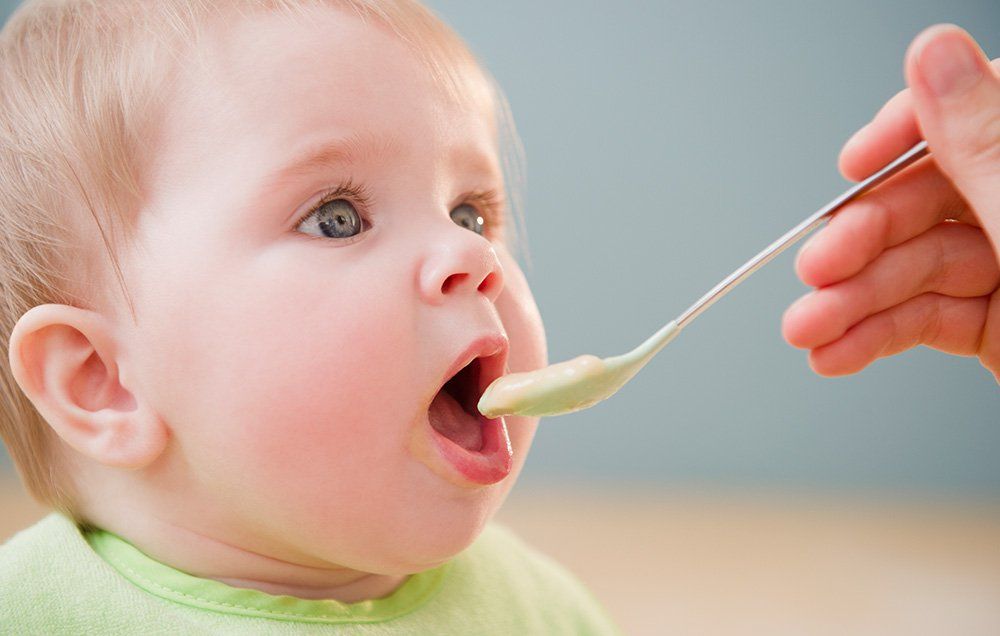 When a baby has gum pain, he becomes restless, throws his chest and cries. All this, of course, is unpleasant.
When a baby has gum pain, he becomes restless, throws his chest and cries. All this, of course, is unpleasant.
However, breastfeeding can be an excellent sedative.
Studies have shown that babies who are breastfed
during the vaccination period cry less and forget pain more quickly. 15 Breastfeeding during teething can have the same calming effect. nine0003
An unpleasant side effect may be the child's attempts to try out his new teeth on the mother's breast. “Sometimes children flirt and bite their mother’s nipples. This can be felt in advance by how the behavior of the child changes when feeding: before biting, he removes his tongue, explains Cathy, “Usually this is not a problem and only happens a couple of times. It is enough to stop feeding, affectionately say that biting is not good, and the baby will soon leave this fun.
How to continue feeding if you have to be separated from the baby? nine0015
It happens that during the first six months, when the baby is still fully breastfed, the mother needs to be away for several hours - or even longer if she has to go to work or go away on business for a couple of days.
But this does not mean that you should stop breastfeeding. You can still feed your baby healthy breast milk - just express it and have someone give it to your baby when you're away. Here's Katie's advice:
“Start expressing milk a couple of days in advance, in small batches, 40-60 ml at a time. So you will have the necessary supply for the time of your absence, but at the same time the amount of milk produced will remain the same. nine0003
If you have to return to work, check with your employer about your daily schedule. Many mothers breastfeed their babies in the morning, evening and night, and pump milk at lunchtime to relieve discomfort and create a reserve for the next day.
This usually turns out to be much easier than one might think, and today many companies are well placed to do this, notes Cathy. “Breast pumps make it easy to solve this problem.”
Natalie, mother from the USA, shares her experience: “I feed Dylan as soon as he wakes up, and sometimes again before leaving for work, in order to maintain milk production and not lose contact with the child. At work, I pump twice the next day (in my absence, he eats two bottles of breast milk), and after work I rush home for the evening feed. I don't pump on the weekends - we resume regular breastfeeding." nine0003
At work, I pump twice the next day (in my absence, he eats two bottles of breast milk), and after work I rush home for the evening feed. I don't pump on the weekends - we resume regular breastfeeding." nine0003
Can breastfeeding continue after the introduction of solid foods?
When your baby begins to show interest in food and can sit up on his own - usually around six months of age - it's time to start solid foods. However, it is not necessary to stop breastfeeding, Cathy explains: “A baby’s iron stores during pregnancy are depleted by six months, so he needs additional sources of this element.
Start complementary foods with solid foods, but remember that breast milk remains a more important source of calories and nutrients until the baby is eight to nine months old. By this time, he will be eating much more solid food, but he will still need to breastfeed four to five times a day. By 12 months, the frequency of feeding may be two to six times a day. All babies are different, and many of them at this age are still getting half their daily calorie intake from breast milk. ” nine0003
” nine0003
Don't forget that breast milk can be added to solid foods, such as cereals and purees, so that the baby can taste the familiar taste. If possible, use milk expressed just before feeding (not thawed) and add just before serving to keep bacteria and nutrients alive. 16
You may be pressured by others to stop breastfeeding when your baby is six months old, but the longer you breastfeed or pump milk, the better for you and your baby. nine0003
How long can I continue breastfeeding?
“The World Health Organization recommends breastfeeding along with solid foods until at least two years of age because it plays an important role in supporting immunity,” says Cathy. feels bad".
At eight months, the baby sometimes breastfeeds four times a day, but by one year old, the frequency of feedings can be reduced to two times a day. You yourself will understand which feeding regimen is more suitable for you and your baby. For example, Jane, a mother of two from the US, breastfed until the age of two: “I breastfed when I was at home - in the evenings and on weekends, when the children wanted to be close to me,” says Jane, “It helped a lot when they were sick . Breastfeeding has become my favorite form of comfort." nine0003
Breastfeeding has become my favorite form of comfort." nine0003
“When my son got a little older and bolder, he still often asked me to breastfeed him - as if to calm down and gain strength,” recalls Amy, a mother of two children from Canada, “When he happened to hit or skin his knee , breastfeeding was a wonderful way to comfort him.”
If your baby is over a year old and you are still breastfeeding, people around you will probably tell you that this way he will never wean. But if children are not pressured, they usually refuse to breastfeed themselves between the ages of two and four. nine0009 17
“I didn’t intend to breastfeed for so long, but as a result, I still breastfeed my four-year-old daughter and 22-month-old son,” says Suzanne, mother of two from the UK, “I breastfeed my youngest before and after work, and in I express milk on business trips. The eldest daughter likes to breastfeed a little before bed or when she is upset - this is a great way to make contact. When I get tired of it, I remind myself what great benefit and comfort it brings them. I now plan to pursue a baby-initiated end breastfeeding strategy — let them decide when to stop.” nine0003
When I get tired of it, I remind myself what great benefit and comfort it brings them. I now plan to pursue a baby-initiated end breastfeeding strategy — let them decide when to stop.” nine0003
For more information on what to expect and lots of tips and tricks, see our guide Breastfeeding Problems After the First Month.
Literature
1 Ballard O, Morrow AL. Human milk composition: nutrients and bioactive factors. Pediatr Clin North Am . 2013;60(1):49-74. - Ballard O., Morrow A.L., "Composition of breast milk: nutrients and biologically active factors." nine0073 Pediatrician Clean North Am. 2013;60(1):49-74.
2 Kent JC et al. Principles for maintaining or increasing breast milk production. J 2012;41(1):114-21. - Kent J.S. et al., "Principles for Maintaining and Increasing Milk Production". J Obstet Ginecol and Neonatal Nurse. 2012;41(1):114-121. nine0073
2012;41(1):114-121. nine0073
3 Kent JC Volume and frequency of breastfeedings and fat content of breast milk throughout the day. Pediatrics. 2006;117(3): e 387-395. - Kent J.S. et al., "Amount and frequency of breastfeeding and fat content of breast milk during the day." Pediatrix (Pediatrics). 2006;117(3):e387-95.
4 Kent JC et al. Longitudinal changes in breastfeeding patterns from 1 to 6 months of lactation. Breast Med . 2013;8(4):401-407. - Kent J.S. et al., Longitudinal changes in breastfeeding patterns from 1 to 6 months of lactation. Brest Med. 2013;8(4):401-407.
5 Almroth S, Bidinger PD. No need for water supplementation for exclusively breast-fed infants under hot and arid conditions. Trans R Soc 1990;84(4):602-604. - Elmroth S.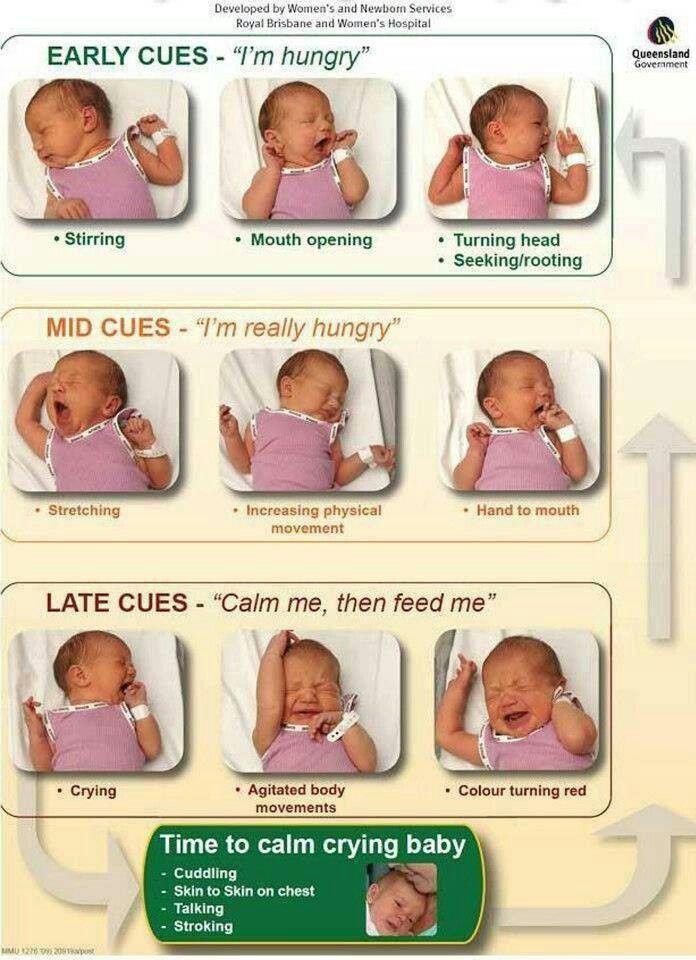 , Bidinger P.D., "No need for supplementation of exclusively breastfed infants in hot, dry conditions." Trans R Sots Trop Med Hyg. 1990;84(4):602-604.
, Bidinger P.D., "No need for supplementation of exclusively breastfed infants in hot, dry conditions." Trans R Sots Trop Med Hyg. 1990;84(4):602-604.
6 Victora CG et al . Breastfeeding in the 21st century: epidemiology, mechanisms, and lifelong effect. Lancet. 2016;387(10017):475-490. - Victor S.J. et al., "Breastfeeding in the 21st century: epidemiology, mechanisms and long-term effects". Lancet 2016;387(10017):475-490.
7 Peres KG et al. Effect of breastfeeding on malocclusions: a systematic review and meta - analysis. Acta Paediatr. 2015;104( S 467):54-61. - Perez K.G. et al., "The impact of breastfeeding on malocclusion: a systematic review and meta-analysis". Akta Pediatr. 2015;104(S467):54-61.
8 Mennella JA, Beauchamp GK. Maternal diet alters the sensory qualities of human milk and the nursling's behavior. Pediatrics. 1991;88(4):737-744. - Mennella, JA, Beauchamp, GK, "Maternal nutrition influences the organoleptic properties of breast milk and infant behavior." nine0073 Pediatrix (Pediatrics). 1991;88(4):737-744.
Maternal diet alters the sensory qualities of human milk and the nursling's behavior. Pediatrics. 1991;88(4):737-744. - Mennella, JA, Beauchamp, GK, "Maternal nutrition influences the organoleptic properties of breast milk and infant behavior." nine0073 Pediatrix (Pediatrics). 1991;88(4):737-744.
9 Hassiotou F et al. Maternal and infant infections stimulate a rapid leukocyte response in breastmilk. Clin Transl immunology. 2013;2(4). - Hassiot F. et al., "Infectious diseases of the mother and child stimulate a rapid leukocyte reaction in breast milk." Clean Transl Immunology. 2013;2(4).
10 Brown A, Harries V. Infant sleep and night feeding patterns during later infancy: Association with breastfeeding frequency, daytime complementary food intake, and infant weight. Breast Med . 2015;10(5):246-252. - Brown A., Harris W., "Night feedings and infant sleep in the first year of life and their association with feeding frequency, daytime supplementation, and infant weight. " Brest Med (Breastfeeding Medicine). 2015;10(5):246-252.
" Brest Med (Breastfeeding Medicine). 2015;10(5):246-252.
11 Infant sleep information source. [Internet]. Normal Infant Sleep Development; December 2017 [cited 2018 Feb] - All about baby sleep. [Internet] "The development of normal sleep in a child", December 2017 [cited February 2018]. nine0073
12 Baby sleep science. [Internet]. The-Four-Month-Sleep-Regression-What-is-it-and-What-can-be-Done-About-it. March 2014 [ cited 2018 Feb ] - The science of baby sleep. [Internet], "Four-month sleep regression: what it is and what to do about it." March 2014 [cited February 2018].
13 The Myth Of Baby Sleep Regressions – What’s Really Happening To Your Baby’s Sleep? [Internet]. Pinky Mckay ; December 2017 [ cited 2018 Feb ] - "The Myth of Baby Sleep Regression - What's Really Happening to Your Baby?" [Internet]. Pinky McKay, December 2017 [cited February 2018].
Pinky McKay, December 2017 [cited February 2018].
14 Kendall - Tackett K ET Al . The effect of feeding method on sleep duration, maternal well-being, and postpartum depression. Clinical Lactation . 2011;2(2):22-26. - Kendall-Tuckett K. et al., "Influence of feeding pattern on sleep duration, maternal well-being and the development of postpartum depression." Clinical Lactation. 2011;2(2):22-26.
15) Harrison D et al. Breastfeeding for procedural pain in infants beyond the neonatal period. Cochrane Database Syst Rev . 2014;10. — Harrison D. et al., "Breastfeeding for Relief of Medical Pain in the Neonatal Period." Cochrane Database of System Rev. 2014;10:CD11248
16 Czank C et al. Retention of the immunological proteins of pasteurized human milk in relation to pasteurizer design and practice. Pediatr Res . 2009;66(4):374. - Zhank S. et al., "Retention of immunological proteins in pasteurized milk depending on the technique and practice of pasteurization". Pediatrician Res. 2009;66(4):374.
Retention of the immunological proteins of pasteurized human milk in relation to pasteurizer design and practice. Pediatr Res . 2009;66(4):374. - Zhank S. et al., "Retention of immunological proteins in pasteurized milk depending on the technique and practice of pasteurization". Pediatrician Res. 2009;66(4):374.
17 Weaning from the breast. (2004). Paediatr Child Health, 9(4):249–253. - "Weaning from the breast" (2004). Pediatrician Child Health, 9(4):249–253.
Stomach problems | Canpolbabies.com
Colic, constipation, diarrhea, vomiting, poisoning, stomach flu? Stomach problems are one of the most common diseases. To effectively deal with them, it is necessary to study the causes and symptoms of various ailments. When you learn to distinguish between them, you can quickly help your baby. nine0003
Colic
Cause
- poor functioning of the gastrointestinal tract
- swallowing too much air during feeding (sucking on the breast)
- digestive problems
What are the symptoms?
If shortly after feeding, the baby begins to arch its back, cry, or have a bloated stomach, it may be colic. How to distinguish normal crying from crying caused by colic? Watch. A child with colic cries for more than 3 hours for more than 3 days, and all this lasts about 3 weeks. Hugs may help for a moment, but if the colic doesn't go away, the baby will continue to cry and won't want to eat anymore. Colic usually occurs between the 2nd and 16th weeks and stops by about 3 months. In addition to crying and bloating, another characteristic sign is bent legs. nine0003
How to distinguish normal crying from crying caused by colic? Watch. A child with colic cries for more than 3 hours for more than 3 days, and all this lasts about 3 weeks. Hugs may help for a moment, but if the colic doesn't go away, the baby will continue to cry and won't want to eat anymore. Colic usually occurs between the 2nd and 16th weeks and stops by about 3 months. In addition to crying and bloating, another characteristic sign is bent legs. nine0003
How to prevent?
First of all, observe if the child is spitting up after eating and massage his tummy.
When you are breastfeeding, drink chamomile and fennel infusions to promote flatulence. Ask your doctor for more information on proper breastfeeding technique to prevent your baby from swallowing too much air.
When the baby is on formula, let him drink the above infusions or fennel water.
If these methods do not help, see a doctor. He will make sure to prescribe the right formula for your baby. However, you should know that colic should simply be experienced, since all methods of treatment bring only a short-term improvement. When the gastrointestinal tract is finally formed, all symptoms will disappear.
However, you should know that colic should simply be experienced, since all methods of treatment bring only a short-term improvement. When the gastrointestinal tract is finally formed, all symptoms will disappear.
Constipation
Causes
- poor functioning of the intestines
- incorrectly selected milk formula
- improper nutrition.
What are the symptoms?
If you suspect that your child is suffering from abdominal pain (he strains and arches his back) and has trouble passing stools, he is most likely suffering from constipation. Check the contents of the diaper. Hard stools (small, compact balls) are also a sign of constipation. Other symptoms include lack of appetite, flatulence. However, if the baby's intestines are emptied by the child less than once a day, but it still has a mushy consistency, then this is not constipation. nine0003
What needs to be done?
1. Exercise for the baby: bend his legs at the knees, gently pressing them to the tummy, and then straighten.
2. Massage: Massage baby's tummy
3. Tea: Give your baby a few teaspoons of fennel tea.
4. Change the child's diet in consultation with a specialist.
5. Call your doctor if:
- your child is regularly constipated.
- constipation occurs rarely, suddenly, but lasts a very long time,
- there is blood in the child's stool. What are the symptoms?
What does diarrhea look like? It is more watery than normal, frothy, and may have an unpleasant sour odor. Other symptoms of diarrhea include abdominal pain, lack of appetite and a general low mood, and a very high fever can also be present. As a rule, during diarrhea, the child empties the bowels more often than usual. You should also check the stool for mucus or blood. nine0003
What to do?
If diarrhea occurs or is suspected, seek medical attention immediately, especially if it is a newborn. Older children should be given plenty of fluids to prevent dehydration. However, often the baby does not want to drink much. Therefore, the best solution is to consult a doctor.
Therefore, the best solution is to consult a doctor.
When you are breastfeeding and your baby has diarrhea, you should be especially careful about what you eat. Do not eat foods that can cause diarrhea or heavy meals. A formula-fed baby should only be allowed to drink for about 4 hours. When transferring the baby to solid food, it is recommended to take foods such as rice or boiled carrots. nine0003
Stomach flu
Causes:
- rotavirus infection of the gastrointestinal tract
What are the symptoms?
You may be familiar with these unpleasant symptoms, because adults with gastric angina experience similar symptoms: diarrhea, vomiting, weakness, lack of appetite, and may also have fever.
What to do?
As in the case of diarrhea, you should immediately contact a doctor who will help the child in the fastest and most effective way. Home methods may not be helpful. nine0003
Poisoning
Possible causes:
- improperly prepared mixture
- eating expired food
What are the symptoms?
Symptoms are similar to stomach flu: diarrhea, vomiting and fever may also occur, and loss of appetite.
What to do?
In this case, you should also contact your doctor immediately.
Parasitic diseases
May occur if:
- there is a pet at home
- baby puts dirty hands or unwashed food in mouth.
What are the symptoms?
When a child has a stomach ache (it does not have to be a sharp pain), no appetite, sleeps restlessly (grinding his teeth, scratching his bottom), he may be infected with parasites. Additional symptoms may include diarrhea, flatulence and constipation, as well as a rash.
What to do?
You should definitely take your child to the doctor. Don't delay, a series of stool tests may be needed. If a doctor diagnoses a parasitic infection, medication will likely be prescribed for the child and the rest of the family. nine0003
Allergies and food intolerances
Possible causes:
- the child may be allergic to, for example, milk or other foods. Make sure this ingredient is not included in his diet.